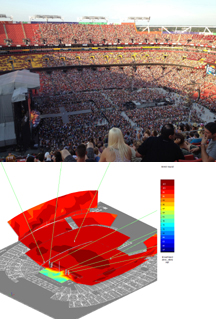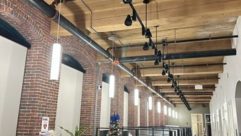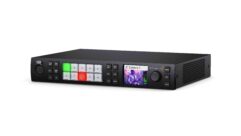
SVC Podcast – Show Notes – Show 148-2
In this edition of the SVC Podcast, SVC Contributing Editor Bennett Liles completes his conversation with John Mills of Morris Light and Sound in Nashville about how sound systems are designed, installed and commissioned. John relates his experience with clients who try to stretch outdated technologies to keep what’s familiar and his tips include finding a few local users who take to a new system most quickly and using them to help teach others how to get the job done.
Links of interest:
- Morris Light and Sound in Nashville, Tennessee
- Morris Light and Sound on Facebook
- NS-1 Prediction Software
- Rational Acoustics – SMAART
Download Podcast Here:
https://s3.amazonaws.com/nb-svc/public/public/148-2_Mills_Audio_System_D…
From Sound & Video Contractor Magazine, this is the SVC Podcast with John Mills of Morris Light and Sound. We have show notes for the podcast on the web site of Sound & Video Contractor Magazine at svconline.com.
Sound system design, installation and commissioning can carry a surprising amount of pitfalls and gotchas. The secret to success is not just found in handling the hardware but in client communication as well. John Mills from Morris Light and Sound is back to wrap up his talk about how to keep these projects on the right track. That’s coming up next on the SVC Podcast.
John, great to have you back with us for Part 2 on the SVC Podcast from Morris Light and Sound in Nashville, Tennessee. Rather than discussing a specific installation on this one we’re talking about the more general topic of sound system design, installation and commissioning. A significant part of this is managing the client. So let’s get into that now. How do you bridge the reality gap that often shows up when you talk to the client and determine what they want versus what they and the facility can really handle?
I think I said the words “can of worms” earlier. This is one of those that everybody knows is always a hard thing to do, and this is where we have good salespeople and good designers that I think do a good job of educating our clients. We try to not just go in and smell some money and sell them a product and get out, we spend a good deal of time with our clients making sure that we understand what they’re looking for. If it were a church, for instance, a lot of churches are making the transition from just doing a choral with maybe an orchestra to a more rock band-driven service. So if that’s a direction that they’re heading or thinking about, the design of that system is way different than the design for a system for, say, the church that just wants a new, better system for doing a choir and orchestra. So we try to talk to them about that. If their vision is we already have this band. They’re working in our youth building, we want to bring them over to the main building and we want to just really blow the doors off the place, we try to help them understand that what they paid for their last system is probably nowhere near what this one is because it’s quite a bit more equipment, quite a bit more technology needed to do that type of sound. I think because we work with them to talk through all of those things, we’re not hiding out in a corner designing the system and then all of a sudden throwing them a big, giant number that scares them. We try to explain to have this kind of capability is roughly $10,000.00 and to do this it’s this piece of that puzzle it’s $50,000.00. So as we’re talking it’s no firm number here, but this project is probably going to run in the neighborhood of $200,000.00. How does that sit with you? If it’s a bigger church, this is probably going to be close to a million dollars by the time we’re done with sound, lights and video here. So if that’s what we’re talking about, great. You just kind of feel them out to see how they react to those kind of numbers. And if they react poorly, sometimes you just go maybe we’re not the integrator for you, if that’s what you have to have but you can’t swallow that budget. You don’t ever say it that way, of course, but a lot of times what we’ve done – like one of our big jobs we did recently is CBC Church in San Antonio. That’s a multimillion dollar project over the last few years we’ve done with them, but the project started about five years ago, I think, and we didn’t do anything with them for almost two years, but it was planning and talking and their systems were fine, but they weren’t big enough to grow into where they were going with the church. They’re one of the biggest churches in the country from what I understand. They were amazing to work with. Their staff was amazing. And the planning that went into it and the multiple trips that went with our CEO who would go down and talk to them many times. He was down for an Easter service years before we did any work with them. Those kinds of relationships build and they build into a trust. They trust us. We trust them. We see their staff. We know who they are. And to carry them on a journey of spending multimillion dollars, it just becomes a journey as opposed to a sale. [Timestamp: 4:07]
And one of the more challenging but creative parts of this comes in then. Once you’ve assessed what they want and what they should be able to do with it, how do you approach the design of the actual user interface where the rubber meets the road on this thing?
Right. I’m a very big fan of locking them out of as much as possible. As much as they can – give them enough rope that they can get the job done, but keep them out of things that they’re going to mess up. So a lot of times what I’ll do is I’ll lock everything down that is anything that would be a high-tech version of the tuning process. For instance I don’t want to give them the ability to adjust the delay between the different zones of the speakers. That’s something that I spend days tweaking and listening to and evaluating, the different tones of the different sections of the PA. In a very large church we’ve got a main hang firing forward and an out hang firing off to the side. I’m not going to give them the ability to EQ those two separately or delay it or level match those things. I’m going to have all that stuff on a layer that I have access to. We almost always, on the bigger ones that have this kind of a system, I can log in and get into their DSP and check things and if he says we really feel like we need three dB more on the underbalcony in section four, okay, cool. I’ll go in and do that for them. But what I do like to give them is the ability to EQ the whole system. Maybe I’ll limit them to having like a plus/minus three on the front fills or the underbalconies where they can’t go too far, but they can have some ability. And then I’ll tell them things like if you feel like you need it, go ahead and punch – you can take three dB up or down on this zone, but if you feel like you’re always doing that, then let me know and we’ll just add that into the preset. And then a lot of times we go back six months or a year later and just check things with them and do a quick tuneup and see how they’re feeling about it. That’s always a really, really great thing that we try to talk them into doing. As we talked earlier about the digital networking and things that are going on these days, there’s so many ways that you can hit one little green light in a grid on a Dante patch that can mess up the entire system. We very strongly encourage, even once they’re past their warranty thing, to call us and talk to us about doing any software upgrades to anything. We had a client that it turned into a nightmare to troubleshoot because he had a problem with one of his video playback devices that was connected via Dante to the whole audio system, which is great. It worked perfect. But he had some other problem with something video related to the product and so the manufacturer said well okay, go ahead and upgrade the firmware. Well, when he upgraded the firmware, it ended up switching Dante back to the default mode, which is not compatible with the mode we had it in to work with the system and he didn’t think to tell us that he had done that because in his mind he had fixed his video problem. He didn’t realize he created the audio problem. So it took us a couple of days of trouble shooting on the phone with him to get kind of sussed out to the point where okay, something changed. What changed? He’s like, “I don’t think this had anything to do with it, but I upgraded the firmware in the video suite on the blah-blah-blah,” and I’m like oh gosh, I wish you would have told me that two days ago. Yeah, that definitely did it because it reset this. So we log in, change the setting and go back and, you know, we all deal with these things, but the more we can lock them out of that they can mess up, the better. But I also don’t want to handcuff them so much because you want the system to be versatile. So I think it just depends in the design phase how we feel about the knowledge level of the client, I think. [Timestamp: 7:16]
Yeah, and I guess on the bigger systems you have to figure in expandability so you don’t have to come in in a couple of years and replace the whole thing.
Right, right. Yeah.
Yeah, so how far do you often see clients trying to stretch a totally outdated technology just because they’re familiar with it? I mean, some people in the educational environment will still scream if you want to take away their VHS tape.
True, right? That’s a tough one, too, because people, they like familiar. I think even more so they don’t necessarily want to spend the money. A lot of people, especially in the church market where we have the guy who’s maybe the plumber by day and the sound guy on the weekend, it’s going to be a lot for him to change and if he’s the only guy doing it, a whole new system is exciting but also scary. So a lot of the times by the time we get to that client who’s ready to do the change, I mean we’re seeing gear that’s 10-15 years old that is literally barely working. One of the jobs we just did down in Georgia, we went in for something different to talk to them about. While we were talking, I said let’s listen to your sound system. He fired something up and one of the mic splitters just literally blew the magic smoke out the front of it. He’s like well, I was going to end the conversation today with we should talk about audio, but since our device decided to let the smoke out, I guess let’s talk about that now. And funny enough, I guess that piece of equipment – they had six or eight of them – it was a good piece, but it had reached its end of life and the way their system was designed it was on 24/7 for 10 years or however long it had been in there. Over the course of the next three or four weeks while we were working with them on their audio design, they were literally blowing one of these things every week or so. [Timestamp: 9:16]
And I guess when you do one of these things you find people onsite that just naturally take to it better and they become the local gurus just teaching the others how to do it.
Yeah. We had a really nice system we did at a church and it was all volunteer-based. And the sound guy finally looks at me after like the second or third weekend I had been there, because it just wasn’t sticking. The pastor said can you come back one more weekend? I don’t think he’s feeling good about it yet. Okay, sure. Yeah, we can. I finally looked at him and I said is this making sense? He said it makes sense, but I don’t hear what you hear. I’m like oh my gosh, you’re the sound guy. I kind of made a really big move during rehearsals on like a guitar sound or something like that, and I mean a big move in my opinion. I’m like do you hear what I’m doing here? Hmmm…nope. I’m like oh my gosh. I’ve literally got my hands on my had and in my mind going what do I do now? What we came up with was one of the ladies, she had been by the booth a couple of times and talked to us a few times. She came by after that service that weekend and I said you seemed to be interested in what we were doing? She said yeah, I’d love to. Is it an option for me to help? I was like yeah, sure. I’m just trying to help them recruit more volunteers. What’s funny is, she didn’t know anything technically. He had learned that console. He knew more buttons and knobs on it than I did, I think, but he couldn’t hear it. So I said to the pastor why don’t we put both of those on? She hears it. She can tell him what to do and he can do it. They called me back two weeks later and were like this is unbelievable. It’s working great. So sometimes two heads are better than one, I guess. [Timestamp: 10:53]
Well, at least they didn’t get in there and try to re-wire it themselves.
We’ve had those too.
I’ll bet. I’ll bet. So what are the central points to remember in audio system design and commissioning? What should we take away from this?
The biggest thing for me is I like to walk away at the end of the project and have everybody feeling good about that. And so the path to do that is to start on the front end with the trust and to start with the design and the conversations that you’re not just feeding them a solution, you’re listening to them. Even if you already know that their solution is a steak dinner, let them understand that they want a steak dinner because then when you deliver it to them, that’s exactly what they wanted and everything ends up working out great. All of the tech and everything in between, it’s just our job to help them understand it as best as possible. Like we said at the beginning, any time we can not have the eyes glossing over in a conversation, it’s best. [Timestamp: 11:46]
Right and sometimes if you give them hamburger and it works right, they’ll think it’s steak.
If that’s what they needed, it sure is.
All right. It’s been great. John Mills from Morris Light and Sound in Nashville. You guys do a lot of sound work and it’s great to hear how you go in and how you approach the client because that sets the tone for the whole thing so I appreciate your being with us.
Thanks. It was fun.
Thank you for being here with us for the SVC Podcast with John Mills of Morris Light and Sound. Show notes are on the website of Sound & Video Contractor Magazine at svconline.com. Join us next week for another SVC Podcast.










